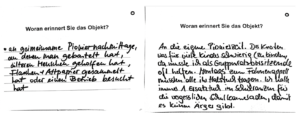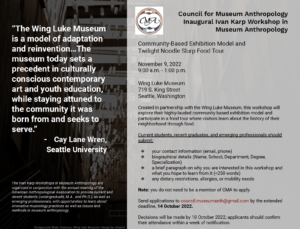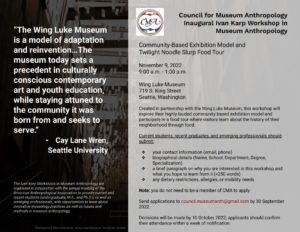In April 2022, the Council for Museum Anthropology (CMA) awarded two awards for excellence in papers presented at the CMA’s Virtual Spring Symposium, The Future is Now: Emerging Perspectives in Museology and Museum Anthropology. Included as part of the prize was the opportunity to publish their paper in the CMA blog. We are pleased to present Inge Zwart’s paper, Participation in Museums: Backstage Ideals and Frontstage Realities.
By: Inge Zwart, PhD student at the Department of ALM at Uppsala University, Sweden.
Introduction
Participatory methods in audience engagement and exhibition production have become increasingly common in museums around Europe. In this paper, I suggest that seeing participation as a way to ‘bringing participants backstage’ rests on a false interpretation of what happens in practice. I analyze a workshop with collections in a German museum, using Goffman’s frontstage and backstage theory to consider where and how front- and backstage divisions are crossed and upheld in this participatory project (1959). The participants might have more and different access to objects, spaces and work in a museum than regular visitors, but I suggest that the behind-the-scenes that participants take part in should be understood as a performance of the museum’s backstage work and spaces. I end by arguing that looking at participation as performance does not necessarily discount the value of such projects, but that its success relies on clear communication and transparency. If that is taken into account, this performative view can introduce functions of such a project that were previously not considered.
The paper is built as follows: first, I briefly introduce the context of my research and the case, and place the paper in relation to contemporary discussions about participation in museums. Then, I explain how I apply ‘backstage’ and ‘frontstage’ after which I present the case and suggest how we might consider what backstage and frontstage is in this type of collection-based participation, and why it matters.
Method, Materials and Terms
The paper is based on empirical data generated and analysis developed for my dissertation research, from ethnographic fieldwork in two Northern European museums. I attended meetings, did interviews with mostly curators, joined in their daily office work, took on small tasks and joined events and workshops, and analyzed internal and public documents. The case study in this paper comes from one of these institutions: the Museum Europäischer Kulturen, or the Museum of European Cultures in Berlin, Germany (MEK). The MEK is an ethnographic museum and holds mostly 19th and 20th century collections of everyday objects from European cultures. According to the director, they have been doing participatory projects with source communities and others for over 20 years – as long as the institution exists in its current form. The project reflected on in this paper was a workshop based on a method called Revisiting Collections, and will be further introduced later on.
In my work, I assume a broad understanding of participation in museums. This understanding encompasses the different ways that museums engage external stakeholders actively. Related terms, which I understand to all fall under the umbrella category ‘participation’, are community engagement (Morse 2021; Crooke 2015), co-creation (Mucha 2022) or co-production (Davies 2010; Kershaw, Bridson, and Parris 2018; Morse, Macpherson, and Robinson 2013). This broad understanding stems from my interviews with curators and staff at two museums. When I asked about their experiences with participation in their museum and their interpretation of the term, the interviewees talked about exhibitions of material created by and stories of participants; art interventions in permanent exhibitions; workshop series for film making, language, printmaking; public events co-organised with various stakeholder groups; exhibition including participants’ narratives based on interviews; workshops through which people are invited to reflect on collections; and audience engagement activities within an exhibition. This broad approach allowed the research interlocutors to define what ‘participation’ means to them, in their museums, to then understand how they do the work necessary to do these projects.
Participation in Museums
With a focus on museum as organizations, I am interested in the work of museum practitioners who do participation in museums. Doing so, I move away from a typical discussion found in literature searching for the ‘best’ type of participation, when authors apply models like Sherry Arnstein’s “ladder of participation” or Nina Simon’s proposed categories of participation to valuate (and critique) projects (Arnstein 1969; Simon 2010). This approach has led to important critical reflections on big projects such as Bernadette Lynch’s oft-cited report about UK-based projects (2012), and to further developed models such as for participatory museum management (Sancho Querol 2021). But, as Nuala Morse (2021) and Helen Graham (2012) suggest, this has also led to a rather stagnant cycle of critique. Instead, I follow Helen Graham’s call for a more practice-based understanding of museum participation (2012).
My argument here builds on Nuala Morse’s critique of the ‘center-periphery argument’ for participation, which views participation from a “logic of contribution” (2021, p. 4). Within this logic, participation is understood as a way through which participants can contribute something to the museum and introduce (positive) outside influence, that could potentially change the institution. Morse challenges this logic, arguing that it limits discussions about participation to issues of choice and control and diminishes potential other motivations, benefits or interests of participants and practitioners alike. I am specifically interested in further unpacking what happens when participation is moved “from the margins of the organisation to the core, into policies, strategies and museum operations” (Morse 2021, 51), by applying Goffman’s backstage and frontstage theory (1959).
Backstage and Frontstage in the Museum
Erving Goffman uses the concepts ‘backstage’ and ‘frontstage’ in his book The presentation of self in everyday life (1959). In it, the sociologist presents his widespread theory about how people try to influence others’ impressions of themselves, using performance language. Goffman discusses frontstage behaviour as that which is done when one is aware of an ‘audience’, while for backstage behaviour one resorts to less performative elements of self.
His popular theory and accompanying performance language is applied in many other social settings, such as work and organizations (Manning 2008). In the museum sphere, where we work with an actual audience, the performance language is easily adapted. It is useful and commonplace to think about what audiences can see and have access to as the frontstage, and what audiences typically do not see as backstage. Where Goffman’s theory is about behaviour in social settings, frontstage and backstage is more loosely applied in relation to museums: in reference to (1) the organizational division of work in the museum, as well as (2) differences in access to space. Sharon MacDonald and Vivian van Saaze both use Goffman’s terms to describe different types of work in museums (Macdonald 2002; Saaze 2011). A division between front-of-house services such as the work done by guards, educators or shop attendants, is often organisationally separated from the typical behind-the-scenes work such as curation, conservation, research, or maintenance. This division comes with a division in spaces as well (Wylie 2020; Engineer and Anthony 2017; Valentine 1982). The spaces typically associated with the second group of museum staff are usually not available for audiences: depots, conservations spaces and offices. The shops, restaurants, exhibition spaces and educations rooms, are places visitors are welcome.
Participatory projects as a backstage ideal
Participation potentially complicates these divisions. In participatory projects, audiences can get acquainted with work that is usually done backstage, especially in the case of co-creating exhibitions, and visitors might have access to spaces that usually are closed for everyday visitors.
It is indeed what one of the curators at the MEK imagined when I asked ‘what would the most perfect participatory project look like for you?’ She answered:
“[To] take the people from other neighbourhoods in Berlin to our place here. That they really cooperate with us here. And not only for exhibitions, but also in the museum, behind the scenes, well in the back office for example, the collections. This would be great. To do this participatory work there.” (MEK curator, interview October 2019)
Just a month after the interview, I attended a workshop in the MEK – organised by a group of students working together with the museum as part of a class – that brought a group of six participants behind the scenes and in connection with the collections. On a late afternoon in November 2019 a so-called Revisiting Collections workshop was organised. This method is developed by Collections Trust and MLA council (Collections Trust and MLA council 2009). In these workshops a group of people are invited to – after hours, outside of the exhibit rooms – interact with and reflect on collection objects from the depot in a structured way. It goes more or less like this:
1. Look at museum objects
2. Answer questions about the objects (see figure 1)
3. Receive collection records about object
4. Respond to records in writing
5. Discuss with the curator about the process and their intepretation
6. Implementation of these interpretations into the collection records
One could argue that in such a workshop, participants are introduced to backstage museum work: they see museum objects that are (typically) not on display, get to handle objects (with gloves) directly, see material from the collection records directly, and can interpret the objects themselves. And, ideally, have an influence on the collection records. A relevant side note here, which reveals something about the complications that might come up in the work with such methods, is that the last step did not take place in this particular case.

Figure 1. Two scanned, written answers to the question “What does this object remind you of” contributed by participants to the workshop.
A closer look
Upon a closer look of this meeting, the practices the participants engage in and the spaces they have access to, are actually mediated by the museum. This makes them more like other mediated encounters with the museum taking place ‘frontstage’, rather than a backstage experience. Furthermore, a backstage and frontstage division remains prevalent on a third level – that of a role division within the participatory interaction.
The participants had access to space and practices they did not have access to as a visitor. The meeting took place in a room in the office building of the museum, usually closed for others. The six participants had access to objects currently not on display, taken from the depot. They also had access to material from the collection records, which are not publicly available.
At the same time, the experience was mediated and limited by the museum. The participants did not get invited into the real conservation spaces, but met in a meeting room in the office building. They were allowed to handle objects, but did not choose the objects themselves, they did not take them from the depot themselves and thus saw the objects outside of their actual ‘backstage’ environment. Further, the participants could only give their personal accounts of these objects: what memories it brought up, and how they have used it. They did not do research on the objects themselves, and did not have access directly into the collection records: the facilitators arranged printed collection records for them to access.
Considering this mediation, there remains a clear division between what practitioners and participants have access to and which work they do in the participatory project itself. The curator and facilitator have clear organizational roles and the participants can react and respond within certain confined framework only created by the museum. A clear example of this took place when participants were excited to bring in some ideas for an exhibition handling these objects. This type of input was not used: the participants had very specific roles to play.
A performance of backstage
In this type of participatory project, museum backstage is ‘performed’. Participants are invited in a simulated way of interacting with objects, but they are not actually invited backstage. They play conservator, in a staged backstage. In this type of museum environment, the division between front- and backstage has shifted: backstage is where the organizational decisions about the workshop were made, including decision making about which objects would be used, where and when this would take place and the setting of goals.
The example shows that participatory projects might allow for access to museum work and spaces that publics usually do not see, but the division between frontstage and backstage remains. Participants are taken into a staged backstage area. The division between front and back stage is upheld by the roles that practitioners and participants alike take on, the respective access they have to material and spaces, and the organizational work they do or not do and thus the influence they have over how the interaction goes.
From a performed backstage to a transparent front
Why does this matter? Participatory practices in museums are often described as an attempt to change the museum from the inside (Morse 2021). Morse already criticises this goal, arguing that relying on external stakeholders to instigate change in turn reduces the responsibility of the museum. Bernadette Lynch highlights the problems that occur when museums are not transparent about how limited external stakeholders’ influence often actually is (Lynch 2011). My empirical data supports their critique by showing that what looks like or is imagined as ‘backstage participation’ rather allows for controlled and limited input and influence from external stakeholders involved. My reflections further suggest that when arguing for participatory projects to take place in, or have an effect on the ‘center’ of the museum, it is important to consider the shifting boundaries of what is center/periphery or backstage/frontstage in a project.
Even though the museum and student facilitators were relatively clear in this case, the importance of clear communication about expectations should be stressed. So that no false ideas of a redivision of power should be given in these cases: participatory projects are indeed rarely, if ever, the way to change museums or to radically redefine the role of the curator.
To end on a more positive note, we might understand this type of project as a new frontstage in which audiences and participants are engaged – rather than as a true engagement with backstage. In this new frontstage, the participant can learn how knowledge is created in a museum setting, be involved in dialogues about representation and what that looks like in practice (decision-making, thinking with objects), and perhaps introduce new materials in the museum records. That is a fairer and more transparent understanding of this type of work and still valuable for museums, participants and practitioners alike.
Acknowledgements
I thank the Museum of European Cultures and the curators, as well as the students and participants involved in the described workshop for welcoming me into their space. This paper has been developed as part of a study in the POEM project (https://www.poem-horizon.eu/) with funding from the European Union’s Horizon 2020 research and innovation programme under the Marie Sklodawska-Curie grant agreement No. 764859. I thank Isto Huvila for reading and commenting on an early version of both the presented and written paper. A final thank you goes out to Hannah Turner, whose comments and edits greatly helped in finalizing the written text.
References
Arnstein, Sherry R. 1969. “A Ladder Of Citizen Participation.” Journal of the American Institute of Planners 35 (4): 216–24. https://doi.org/10.1080/01944366908977225.
Carpentier, Nico, Ana Duarte Melo, and Fábio Ribeiro. 2019. “Rescuing Participation: A Critique on the Dark Participation Concept.” Comunicação e Sociedade, no. 36 (December): 17–35.
Collections Trust, and MLA council. 2009. Revisiting Museum Collections. 3rd ed. London: Collections Trust.
Crooke, Elizabeth. 2015. “The ‘Active Museum’: How Concern with Community Transformed the Museum.” In Museum Practice, edited by Conal McCarthy, 481–502. The International Handbooks of Museum Studies. West Sussex, UK: John Wiley & Sons, Ltd.
Davies, Sue M. 2010. “The Co-Production of Temporary Museum Exhibitions.” Museum Management and Curatorship 25 (3): 305–21. https://doi.org/10.1080/09647775.2010.498988.
Engineer, Altaf, and Kathryn H. Anthony. 2017. Shedding New Light on Art Museum Additions: Front Stage and Back Stage Experiences. London: Routledge. https://doi.org/10.4324/9781315443164.
Goffman, Erving. 1959. The Presentation of Self in Everyday Life. Anchor Books 174. New York: Doubleday.
Graham, Helen. 2012. “Scaling Governmentality.” Cultural Studies 26 (4): 565–92. https://doi.org/10.1080/09502386.2012.679285.
Kershaw, Anne, Kerrie Bridson, and Melissa A. Parris. 2018. “Encouraging Writing on the White Walls: Co-Production in Museums and the Influence of Professional Bodies: Co-Production in Museums and the Influence of Professional Bodies.” Australian Journal of Public Administration 77 (1): 19–34. https://doi.org/10.1111/1467-8500.12245.
Lynch, Bernadette. 2011. “Whose Cake Is It Anyway? A Participatory Investigation into Engagement and Participation in 12 Museums and Galleries in the UK.” London: Paul Hamlyn Foundation.
Macdonald, Sharon. 2002. Behind the Scenes at the Science Museum. Materializing Culture. Oxford: Berg.
Manning, Peter K. 2008. “Goffman on Organizations.” Organization Studies 29 (5): 677–99. https://doi.org/10.1177/0170840608088767.
Morse, Nuala. 2021. The Museum as a Space of Social Care. London ; New York: Routledge.
Morse, Nuala, Morag Macpherson, and Sophie Robinson. 2013. “Developing Dialogue in Co-Produced Exhibitions: Between Rhetoric, Intentions and Realities.” Museum Management and Curatorship 28 (1): 91–106. https://doi.org/10.1080/09647775.2012.754632.
Mucha, Franziska. 2022. “Co-Creative Events for Engagement with Digital Cultural Heritage Collections.” PhD, University of Glasgow. https://theses.gla.ac.uk/82754/.
Saaze, Vivian Van. 2011. “Going Public: Conservation of Contemporary Artworks.” Revista De História Da Arte 8: 235–49.
Sancho Querol, Lorena. 2021. “The SoMus Project: Close-up on Innovative Participatory Management Models in European Museums.” Les Cahiers de Muséologie, October. https://popups.uliege.be/2406-7202/index.php?id=396.
Simon, Nina. 2010. The Participatory Museum. Santa Cruz, CA: Museum 2.0.
Valentine, Catherine. 1982. “The Everyday Life of Art: Variation in the Valuation of Art Works in a Community Art Museum.” Symbolic Interaction 5 (1): 37–47. https://doi.org/10.1525/si.1982.5.1.37.
Wylie, Caitlin Donahue. 2020. “Glass-Boxing Science: Laboratory Work on Display in Museums.” Science, Technology, & Human Values 45 (4): 618–35. https://doi.org/10.1177/0162243919871101.



